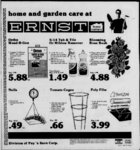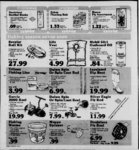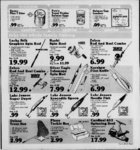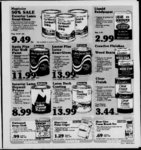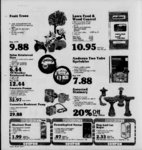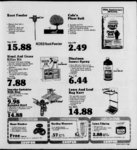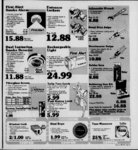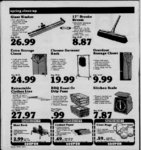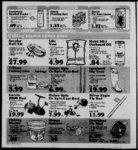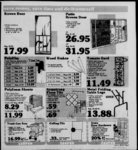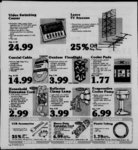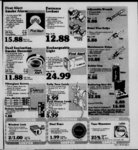| OCR Text |
Show . i ', ' - , , ' ;' yv,.' VS' we should expect those cycles to continue. Murphy said sunspots may attriof the wind out of those stories which parents and grandparents bute to the cycles. A sunspot is a By DAN CARLSRUH like to tell. Wasnt it they who told massive sun storm which produces Review Staff It seems as if the weather hasnt horror stories of winters so cold areas of relatively cooler temperatures on the surface. Its these been acting like it should. Theres that you could break off a mousbeen so much water these past few' tache with a flick of the fingers or spots on the sun which Murphy months that the neighbor has been of summers so hot that eggs were feels may influence the earths climates. Exactly how they change running around the neighborhood precooked in the shell and even the the climate still isnt fully undergathering animals in sets of two. pine trees wilted. Those stories may not have a lot stood. Your dog has gotten used to wearBut that warming trend has had of truth to them, according to Murhis while innertube paddling ing a some do but have reprieve in the past year, when around the yard. Youve been wet phy, logic. they Back in the 20s, people didnt get the Mexican volcano, El Chinchon-a- l, so long that the last time you threw its ash into the stratosinto nice heated cars when they looked in the mirror you resembled a prune. The TV shows you traveled into town. They had Mod- phere in March 1982, where it of partipictures of your favorite fishing el Ts. So a cold night would seem spread into a thin layer hole which now has the width of the insufferable. In the summer, cles. Those particles, which gave sunsets last sumMississippi and the flow of the homes didnt have the air condi- such brilliant surface temperalowered mer, we To now. have them, Colorado. tioning tures. But at the same time,' The Great Salt Lake is lapping at looking back, those days were colyour doorstep and the hill behind der in the winter and hotter in the said Alder, some scientists think that the ash warmed the stratossummer. you groans in the night. Everyof WeathBill Alder the National phere, causing different atmosthing is sopping wet. The climate has changed but it er Service agrees with the change pheric currents which eventually isnt time to pack up and move to in the climate. Weve taken 30 caused El Nino, the Pacific curJackson, Mo., or wait for the Rap- year intervals, from 1941 to 1970 rents. El Nino, meaning the Christ and both time ture on your roof top. Change is and from since the currents usually show Child, a is Utah that getting just the norm for this globe and the spans have been observed around Christweather is just one of the easiest, tad warmer and wetter. Though the records show Utah mas, has been the most immediate and first, to be noticed. warmer and wetter, there concern for Utah and Davis Coungetting to Don But, according Murphy, is only guesswork if the change ty residents. El Nino is a large professor of geology of Weber continue. Scientists have di- body of water in the Pacific which will is State College, the change minimal. There hasnt been any vergent views. Some say there will has risen in temperature from four drastic changes in the climate for be a return to a glacier age, others to six degrees. The warmer water think just the opposite will happen. brews numerous storms allowing He demore than 100 years. Both sides can show records and them to reach further inland, givscribes drastic as any fluctuation of the annual mean tempera- charts for their educated guesses, ing extra moisture to Utah. but they remain guesses. Moisture, which is usually a ture of two degrees or more. to Utah, has now become to commit either didnt blessing Murphy as as the small Nevertheless, a curse. The delicate desert strucchange might be, there has been a viewpoint, only that, at least for ture needs a balance or the soil change. Since the 1920s, our wint- the past decades, a cycle appears.'. The climate pattern in Utah ap becomes saturated which in turn ers in Utah have been a little colder and the summers a little war pears to run in cycles and causes slides. mer and wetter, said Murphy. A statement like that takes some ' ftbfAyyb, ssasx' XXX-- ' , , ,; " ,il":.i,t',,(,' ,n ' ;;XX'Xx$, $k!f - Sfe-- I aaaa i fjCi X " 1951-198- 0, Jit if And if Utah doesnt return to its normal temperatures soon, residents may still have a chance to pack up or wait on their rooftops. But the extra clouds give another curse. It allows evapora tion and it is evaporation which has made living in the valley a possibility. According to state climatology records, Utah receives 58 million acre feet of water through precipitation a year. Of that, only two million acre feet leave the state through creeks and rivers. The rest, some 56 million acre feet, leave through evaporation. The Great Salt Lake itself loses more than 3 million acre feet of water a year through evaporation. If that process stopped, the lake would rise 42 vertical inches a year. Total loss of evaporation could only occur if the Great Salt Lake was frozen, but even slowing down the process can mean drastic changes for valley residents. The record high of the Lake in modern time has been set at 4,212 feet above sea level in 1873. The low point occurred 90 years later on Oct. 31, 1963, when the Lake receded 21 feet at 4,191.35 feet above sea level. 22-ye- ar The New Ufcohn's Club Welcomes (People fo Ufleah By CHERYL ARCHIBALD Raviaw Corraipondant BOUNTIFUL The New Utahns Club in Bountiful recently elected its officers for the 1983- 84 year. Formerly the South Davis Welcome Wagon, the club boasts members from California to New York and has been in existence for 10 ; ; : ; years. Margy Campbell, the clubs new president, said most of the members were transferred to Utah from other states because of their husbands jobs. We have women who are young mothers and others who are in their 60s, she said. The Welcome Wagon had rules stating that members can only belong to the club for three years, and Ms. Campbell said that they didnt .want to have that limitation so they formed their :own New Utahns. Dues are $6 a year and there are three meetings month except in June, July and August. One Thursday a month they go to a restaurant ;for lunch. Wednesday is their business meeting and Tuesday morning at the Community Church in Bountiful they have a social and coffee time. Baby sitting is 500 per child. Nine times a year husbands and wives get : 1 ; ; : ; together for a social event with a progressive! dinner. Anyone interested in attending the dinner on June 11, can call Margy Campbell, Different groups within the club are the golf club, several bridge clubs, a gourmet club and a 298-258- 2. service group. For the last three years money was raised by the ladies and given to the Monte Vista School. They collect and donate food to the Community Churchs pantry for those in need. Ms. Campbell said club members can pick and choose which meetings they wish to attend. Were here to lend a hand to people in helping them to get to know the South Davis area. We refer newcomers to different services, such as doctors and dentists. All members keep their eyes and ears open for new members. Rose Smith, membership chairman, makes contact with new people. Were on our own in getting contacts, going by publicity and word of mouth.' Other new officers are: first vice president, Linda Gullion; second vice president, Kathy Mof-fe- t; Erika Buervenich; corresponding secretary, Kathy Welker; historian, Janet Ling; and publicity, Marge Ashton. secretary-treasure- r, For Film i Photographs of Mercur Wanted Old photographs of the former Utah mining town of Mercur are needed by the Brigham Young University Media Production Studio to motion pic- complete an educational-historicture on what was one of the states most colorful ; communities and eras. Peter Czerny, project manager for the movie Mercur, Utah: The Town That Cant Stay Dead, said that photos of the town during any of its existence would be important to the movie. But were especially interested in photos from the 1930s to 1940s period, he added. We already ; have some in the movie, but need more to enrich the visual aspect of the film. The motion picture is being produced under the auspices of the BYU Department of Antrhopology and its Museum of Peoples and - Cultures, located at Allen Hall near campus. The movie is part of the departments histor-- f program. Primary funding for ; ical archaeology ; : the project has come from Getty Oil, which has : ! built a processing plant at the old mining site. The plant is already in production, Czerny said. Under the supervision of Dr. Dale Berge, direj ctor of the Museum of Peoples and Cultures, ' al ' ' ' te (archaeological research crews have already N found a large number of artifacts. Their excavations were completed under a contract between RYU and Getty Oil during the time construction was taking place at the site. In just one section of the former town, archaeologists found more china and remnants of china dolls than have been found in any other site excavated in the state, Czerny pointed out. Mercur was one of few Utah towns that imported almost everything. Other Utah towns were often raising food crops and animals. But Mercur was in a canyon and had no place for farming. The movie covers the period from the time the town first sprang up in 1870 to the present Getty operation. The town had blossomed into Utahs second largest city around the turn of the century, with a population of about 5,500. Fire destroyed the city and most if its homes in 1902. It was built up partially after the fire, but its mine was closed in 1913 because of foreign gold competition. It reopened in the 1930s, but soon closed for the third time. Most of the buildings had been gutted by looters, leaving only rock walls and mining remnants. The movie is being narrated by Denver Pyle, who portrays .Uncle Jessie in the TV series Dukes of Hazzard. Anyone who has photos on Mercur for any period and would like to lend them for possible use in the movie should contact Czerny at BYU, self-sufficie- 378-728- 0. Read The Classified For Best Results i |





















